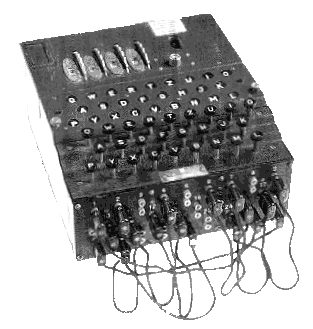Enigma Machine
The history of the Enigma machine begins in 1923 when the Chieffrienmaschinen Aktien Gesellschaft (Cipher Machine Coorporation) showed for the first time at the Bern International Postal Congress in Switzerland, the Enigma cipher machine, model A
The enigma Model A was heavy and bulky, a typewriter keyboard was used to make the messages
It could be used as a typewriter or to encode a text. Enigma A did not place great success despite the publicity that aroused
Three other models succeeded him, models B, C and D. Model B was similar to model A with the exception of rotors, which had 26 contacts while model A was 28. The C and D models were more manageable and cryptographically different than their predecessors
These last two models operated under principles similar to Hebern's machine, with some important differences

Models C and D had 26-pin rotors, the fourth rotor was nothing more than a reflector-serviating half-rotor. The reflector was used to allow the signal to pass back through the first three rotors using a different path
Therefore, if we denote the rotors for R, I, II and III such that rotor III is the first to the right, then the signal will follow the following path: III, II, I, R, I, II, III
The principle of the reflector was invented by Hugo Koch and implies that little matter the position of the rotors given a letter, if we say A, it will be encoded to become W then W will become A once encoded
This means that each machine-encoded alphabet is reciprocal. More than that, a letter cannot be encoded by itself, the refectory does not allow to cross the direct path. This method simplifies decrypting a message. Simply put the machine in its initial state. Model D was a commercial version, sold on a large scale
A large number of governments quickly bought Enigma for study. Stakeholders included the German navy and the Japanese. The German navy decided to launch an Enigma machine the following year
The German army redesigned the machine in June 1930, being the final standard version, calling it Enigma I, beginning to be used within the army. Of this model would appear various variations used by the German navy from October 1934 and by aviation from August 1935
The improvements that will be brought to Enigma will be continuous throughout the duration of the war. The Germans bet on Enigma's effectiveness in achieving victory. All government and defense charges used Enigma to make their encrypted communications
Against the high level of encryption, Enigma's secret transmissions were regular, and often resolved by allied cryptoanalysts. Alan Turing played an important role in carrying out this task
The discovery of military secrets, containing capital strategic information, allowed the Allied forces to gain some advantage and accelerate the end of the war
